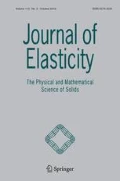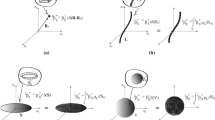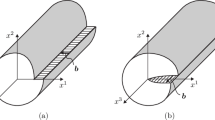Abstract
The kinematic theory of Weingarten-Volterra line defects is revisited, both at small and finite deformations. Existing results are clarified and corrected as needed, and new results are obtained. The primary focus is to understand the relationship between the disclination strength and Burgers vector of deformations containing a Weingarten-Volterra defect corresponding to different cut-surfaces.






Similar content being viewed by others
Notes
As an aside, Zubov’s notation is non-standard, e.g., the action of a tensor \({\boldsymbol{A}}\) on a vector \({\boldsymbol{b}}\) is written as \({\boldsymbol{b}}\cdot {\boldsymbol{A}}\); for \(Q^{M}\) (curvilinear) coordinates on the current configuration with position vectors represented as \({\boldsymbol{R}}\) and \(q_{s}\) as coordinates on the reference configuration with position vectors represented as \({\boldsymbol{r}}\), the deformation gradient is written as \(( \frac{\partial Q^{M}}{\partial q^{s}} ) {\boldsymbol{r}} ^{s} \otimes {\boldsymbol{R}}_{M}\), where \({\boldsymbol{r}}^{s}\) represents (an element of) the dual basis in the reference configuration corresponding to coordinates \(q_{s}\), and \({\boldsymbol{R}}_{M}\) is the natural basis in the current configuration (instead of the more standard notation that would be \(( \frac{\partial Q^{M}}{\partial q^{s}} ) {\boldsymbol{R}}_{M} \otimes {\boldsymbol{r}}^{s}\); the correspondence of upper and lower case letters with objects on the current and reference configuration in this footnote also follows Zubov’s notation).
References
Acharya, A., Fressengeas, C.: Continuum mechanics of the interaction of phase boundaries and dislocations in solids. In: Chen, G.-Q.G., et al. (eds.) Differential Geometry and Continuum Mechanics. Springer Proceedings in Mathematics and Statistics, pp. 125–168 (2015)
Casey, J.: On Volterra dislocations of finitely deforming continua. Math. Mech. Solids 9(5), 473–492 (2004)
Delphenich, D.H.: On the equilibrium of multiply-connected elastic bodies. English translation of [14]. http://www.neo-classical-physics.info/theoretical-mechanics.html
Delphenich, D.H.: On the surface of discontinuity in the theory of elasticity for solid bodies. English translation of [15]. http://www.neo-classical-physics.info/theoretical-mechanics.html
Dollard, J.D., Friedman, C.N.: Product Integration with Application to Differential Equations. Encyclopaedia of Mathematics and Its Applications, vol. 10. Cambridge University Press, Cambridge (1984)
Gurtin, M.E.: The linear theory of elasticity. In: Linear Theories of Elasticity and Thermoelasticity. Handbuch Der Physik, vol. VI, pp. 1–295. Springer, Berlin (1973)
Dimon Kellogg, O.: Foundations of Potential Theory. Dover, New York (1954)
Kupferman, R., Moshe, M., Solomon, J.P.: Metric description of singular defects in isotropic materials. Arch. Ration. Mech. Anal. 216(3), 1009–1047 (2015)
Love, A.E.H.: A Treatise on the Mathematical Theory of Elasticity. Dover, New York (1944)
Nabarro, F.R.N.: Theory of Crystal Dislocations. Dover, New York (1987)
Shield, R.T.: The rotation associated with large strains. SIAM J. Appl. Math. 25(3), 483–491 (1973)
Sokolnikoff, I.S.: Tensor Analysis: Theory and Applications, 3rd edn. Wiley, New York (1958)
Thomas, T.Y.: Systems of total differential equations defined over simply connected domains. Ann. Math. 35, 730–734 (1934)
Volterra, V.: Sur l’équilibre des corps élastiques multiplement connexes. Ann. Sci. Ec. Norm. Super. 24, 401–517 (1907)
Weingarten, G.: Sulle superficie di discontinuità nella teoria della elasticità dei corpi solidi. Rend. R. Accad. Lincei, Cl. Sci., Fis., Mat., Nat. 10(1), 57–60 (1901)
Yavari, A.: Compatibility equations of nonlinear elasticity for non-simply-connected bodies. Arch. Ration. Mech. Anal. 209(1), 237–253 (2013)
Zubov, L.M.: Nonlinear Theory of Dislocations and Disclinations in Elastic Bodies. Lecture Notes in Physics, New Series: Monographs, vol. 47. Springer, Berlin (1997)
Acknowledgements
I am very grateful to Reza Pakzad and Raz Kupferman for their valuable comments and discussion. I thank Reza for reading the whole paper and Raz for taking a look at the finite deformation part. I also thank Reza for showing me alternative proofs of the main results of this paper for bodies in two space dimensions with a single hole without involving any line or product integrals, but capitalizing only on appropriate statements of rigidity. I acknowledge the support of the Center for Nonlinear Analysis at Carnegie Mellon and grants ARO W911NF-15-1-0239 and NSF-CMMI-1435624.
Author information
Authors and Affiliations
Corresponding author
Additional information
Publisher’s Note
Springer Nature remains neutral with regard to jurisdictional claims in published maps and institutional affiliations.
Appendix: Strain Compatibility on a simply connected region
Appendix: Strain Compatibility on a simply connected region
For the sake of completeness we collect some classical results related to questions of strain compatibility in the following sections. All regions considered in these appendices are simply connected, unless mentioned otherwise. We repeatedly use the argument that if \(f_{,k} = 0\) on the domain then \(f\) is a constant, which uses the fact that the region in question is path connected.
1.1 A.1 Small deformation
Theorem A.1
Given a\(C^{2}\)second-order tensor field\(\boldsymbol{\varepsilon }\)on a simply connected region, it is necessary and sufficient for the existence of a\(C^{3}\)displacement field\({\boldsymbol{u}}\)on it satisfying\((\operatorname{grad} {\boldsymbol{u}})_{sym} = \boldsymbol{\varepsilon }\)that the St.-Venant compatibility condition (1)3be satisfied.
Proof
Necessity—\(u_{i}\) exists satisfying
The infinitesimal rotation \(\boldsymbol{\omega }\) is twice continuously differentiable and therefore, \(\omega _{ik,lm} - \omega _{ik,ml} = 0\) implies (1)3.
Sufficiency—We assume (1)3 is satisfied and define
where \({\boldsymbol{c}}_{({\boldsymbol{x}}_{0},{\boldsymbol{x}})}\) is some path in the region from \({\boldsymbol{x}}_{0}\) to \({\boldsymbol{x}}\) and \({\boldsymbol{W}}\) is an arbitrary skew-symmetric tensor. Since \(E_{ikl,m} = E_{ikm,l}\) due to (1)3, \(\boldsymbol{\omega }\) as defined in (26)2 is independent of path, and defines a smooth function that satisfies
on the region which is unique up to the choice of \(\boldsymbol{\omega }({\boldsymbol{x}}_{0}) = {\boldsymbol{W}}\). Since (27) and (26)1 imply
the definition
for any \({\boldsymbol{u}}^{0}\) an arbitrary constant vector, is independent of the path \({\boldsymbol{c}}_{({\boldsymbol{x}}_{0}, {\boldsymbol{x}})}\) chosen to connect \({\boldsymbol{x}}_{0}\) and \({\boldsymbol{x}}\), and hence defines a smooth displacement field whose symmetrized gradient equals the given \(\boldsymbol{\varepsilon }\) field. □
1.2 A.2 Rigidity for smooth infinitesimal deformations
Theorem A.2
If two\(C^{1}\)displacement fields on a region have identical strain fields, then they differ at most by an infinitesimally rigid deformation. The region here need not be simply-connected.
Proof
Let \({\boldsymbol{u}}^{1}\) and \({\boldsymbol{u}}^{2}\) be the two displacement fields with strain fields \(\boldsymbol{\varepsilon }^{1}\) and \(\boldsymbol{\varepsilon }^{2}\) and rotation field \(\boldsymbol{\omega }^{1}\) and \(\boldsymbol{\omega } ^{2}\), respectively, defined from the corresponding displacement fields by relations (25) and let \(\boldsymbol{\varepsilon }^{1} = \boldsymbol{\varepsilon }^{2}\). Then
using a similar computation as in (25), and therefore \({\boldsymbol{W}}: = \boldsymbol{\omega }^{1} - \boldsymbol{ \omega }^{2}\) is a constant skew-symmetric tensor on the region (which is path-connected). We then have
and integrating along paths from an arbitrarily fixed \({\boldsymbol{z}}\) to all points \({\boldsymbol{x}}\) in the region and rearranging terms we obtain
Since \({\boldsymbol{z}}\) was arbitrarily fixed, this implies that \({\boldsymbol{u}}^{1}\) and \({\boldsymbol{u}}^{2}\) are related by an infinitesimally rigid deformation by Definition 6. □
1.3 A.3 Finite deformation
The treatment here is from Sokolnikoff [12]. While the considerations below relate to fundamental relations in Riemannian geometry, we intentionally emphasize the purely algebraic fact that if the functions \(h,g,x,y\) (defined below) satisfy (28), then they necessarily satisfy (31) and the definition (29) implies (32).
Let \(\varOmega _{x}\) and \(\varOmega _{y}\) be two 3-d coordinate patches, i.e., open bounded regions of \(\mathbb{R}^{3}\), and let \(y:\varOmega _{x} \rightarrow \varOmega _{y}\) be a \(C^{2}\) diffeomorphism with a \(C^{2}\) inverse that we denote by \(x:\varOmega _{y} \rightarrow \varOmega _{x}\). Let \(h:\varOmega _{y} \rightarrow \mathbb{R}^{3\times 3}\) and \(g:\varOmega _{x} \rightarrow \mathbb{R}^{3\times 3}\) be two prescribed matrix fields with range in the set of symmetric, positive definite \(3\times 3\) matrices. In the following all indices range over the set \(\{ 1,2,3\}\). Assume
holds. Then, using the symmetry of \(g_{\alpha \beta }\) (and switching some dummy indices),
Now define \(\hat{\varGamma }:\varOmega _{x} \rightarrow \mathbb{R}^{3 \times 3 \times 3}\) and \(\hat{H}:\varOmega _{y} \rightarrow \mathbb{R} ^{3 \times 3 \times 3}\) as
Then,
Next we define \(H: \varOmega _{y} \rightarrow \mathbb{R}^{3 \times 3 \times 3}\) and \(\varGamma : \varOmega _{x} \rightarrow \mathbb{R}^{3 \times 3 \times 3}\) by
where \(h^{km}\) and \(g^{\alpha \beta }\) are the components of the matrices \(h^{-1}\) and \(g^{-1}\), respectively. We note that \(\hat{H}, H, \hat{\varGamma }, \varGamma \) are all symmetric in their lower first two indices. Noting from (28) that
we obtain
which, after rearrangement of terms, yields
Of course, the computations above indicate that interchanging the list \(( x,y, g,g^{-1}, h, h^{-1}, \hat{\varGamma }, \hat{H}, \varGamma , H ) \) by \(( y,x, h, h^{-1}, g,g^{-1}, \hat{H}, \hat{\varGamma }, H, \varGamma ) \) in the above formulae is admissible. We thus have
Another result we will need for our compatibility argument to follow is as follows:
so that
which implies
Let \(\varOmega \) be a simply connected region and let \({\boldsymbol{C}}: \varOmega \rightarrow {\mathcal{{P}}}_{sym}\) be a prescribed \(C^{2}\) field on \(\varOmega \), where \(\mathcal{{P}}_{sym}\) is the set of all positive-definite, symmetric tensors on \(V_{3}\). Let \(\varOmega _{x}\) be a Rectangular Cartesian coordinate patch parameterizing \(\varOmega \) and \(C:\varOmega \rightarrow \mathbb{R}^{3 \times 3}\) be the component map of \({\boldsymbol{C}}\) with respect to the rectangular Cartesian basis of the parametrization of \(\varOmega \) by \(\varOmega _{x}\).
Theorem A.3
If there exists a deformation\({\boldsymbol{y}}: \varOmega \rightarrow {\mathcal{{E}}}_{3}\)satisfying
then (1)2is satisfied in\(\varOmega \). Conversely, if the matrix field\(C\)satisfies (1)2, then there exists a deformation\({\boldsymbol{y}}: \varOmega \rightarrow {\mathcal{ {E}}}_{3}\)that satisfies (33).
Proof
Necessity of (1)2 for (33)—Let \(y: \varOmega _{x} \rightarrow \varOmega _{y} \subset \mathbb{R}^{3}\) be the coordinate map representing the parametrization of \({\boldsymbol{y}}(\varOmega )\) by the same Rectangular Cartesian system for \(\mathcal{{E}}_{3}\) used to parametrize \(\varOmega \). Then
holds. Making the identification of \(h = I\) and \(g = C\) in (28), we have \(H = 0\) and (31) implies
Due to the smoothness of \({\boldsymbol{C}}\) and (34) we obtain
and since \(F\) is an invertible matrix (due to \({\boldsymbol{C}}\in {\mathcal{{P}}}_{sym}\)), (1)2 holds.
Sufficiency of (1)2 for (33)—By a theorem of Thomas [13] (also the Froebenius theorem in the differential geometry literature), we have that a solution to (34) exists, with freely specifiable value of \(F\) and \(y\) at arbitrarily chosen points of \(\varOmega _{x}\), if \(\varGamma^{\gamma }_{\alpha \beta } = \varGamma^{\gamma }_{\beta \alpha }\) (which holds by definition of \(\varGamma \)), and (1) 2 hold.
Specify the value of \(F\) at an arbitrarily chosen point \(x_{0} \in \varOmega _{x}\) such that \(F^{i}_{\alpha }(x_{0}) F^{i}_{\beta }(x_{0}) = C_{\alpha \beta } (x_{0})\), written alternatively as \(F_{0}^{T} F_{0} = C_{0} \Longrightarrow F_{0} C^{-1}_{0} F_{0}^{T} = I\). For an \(F\) field satisfying (34) with the identification \(C = g\) in (29) and (32), consider now
by (32). Thus we have that
and defining \({\boldsymbol{y}}= y^{i} {\boldsymbol{e}}_{i}\) where \({\boldsymbol{e}}_{i}, i = 1,2,3\) is the (spatially constant) natural basis of the Rectangular Cartesian coordinate system used to parametrize \(\varOmega \), we find that \({\boldsymbol{y}}\) satisfies (33). □
1.4 A.4 Rigidity for smooth finite deformations
Let \({\boldsymbol{y}}^{*}:\varOmega \rightarrow {\mathcal{{E}}}_{3}\) and \({\boldsymbol{z}}:\varOmega \rightarrow {\mathcal{{E}}}_{3}\) be two \(C^{2}\) deformations of \(\varOmega \). Consider a rectangular Cartesian parametrization of \(\mathcal{{E}}_{3}\) under which \(\varOmega \) maps to the set of coordinates \(\varOmega _{x} \subset \mathbb{R}^{3}\), \({\boldsymbol{y}} ^{*}(\varOmega )\) maps to \(\varOmega _{y}\), and \({\boldsymbol{z}}(\varOmega )\) maps to \(\varOmega _{z}\). Let \(y^{*}:\varOmega _{x} \rightarrow \varOmega _{y}\), \(z:\varOmega _{x} \rightarrow \varOmega _{z}\), \(y:\varOmega _{z} \rightarrow \varOmega _{y}\), and \(x: \varOmega _{z} \rightarrow \varOmega _{x}\) be the corresponding deformations, represented in coordinates. \(\varOmega \) need not be simply connected.
Theorem A.4
If\({\boldsymbol{y}}^{*}\)and\({\boldsymbol{z}}\)have the same right Cauchy-Green tensor fields then they are rigidly related to each other.
Proof
We have, following [11],
and identifying \(x\), \(h\), and \(g \circ x\) in (28) with \(y\), \(I\), and \(I\), respectively, here, we have from (30) that
Due to the path connectedness of \(\varOmega _{z}\) (induced from \(\varOmega _{x}\)), this implies that there exists a constant matrix \(R\) satisfying \(y^{\alpha }_{,p} = R^{\alpha }_{p}\) on \(\varOmega _{z}\) with \(R^{T}R = I\) from (35)3. Integrating along an arbitrarily chosen path from \(z(w_{0}) \in \varOmega _{z}\) to \(z(w) \in \varOmega _{z}\) for \(w_{0}, w \in \varOmega _{x}\), we obtain
for any \(w \in \varOmega _{x}\) and \(w_{0} \in \varOmega _{x}\) and therefore \({\boldsymbol{y}}^{*}\) and \({\boldsymbol{z}}\) are rigidly related to each other by Definition 5. □
Rights and permissions
About this article
Cite this article
Acharya, A. On Weingarten-Volterra Defects. J Elast 134, 79–101 (2019). https://doi.org/10.1007/s10659-018-9681-6
Received:
Published:
Issue Date:
DOI: https://doi.org/10.1007/s10659-018-9681-6




